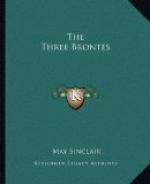Mr. Malham-Dembleby’s work of identification is made easier for him by his subsidiary discovery of Charlotte’s two methods, Method I, interchange of the sex; Method II, alteration of the age of her characters. With this licence almost any character may be any other. Thus Hareton Earnshaw looking at Catherine is Jane Eyre looking at Mr. Rochester. When he touches her Nelly Dean says, “He might have stuck a knife into her, she started in such a taking”; and Rochester says to Jane, “You stick a sly penknife under my ear” (parallel passage!). Lockwood at Wuthering Heights is Jane Eyre at Thornton Hall; Heathcliff appearing at Lockwood’s bedside, besides being M. Heger and Rochester, is Rochester’s mad wife. Heathcliff returning to Catherine is Jane returning to Rochester, and so on. But however varied, however apparently discriminated the characters, M. Heger is in all the men, and Charlotte is in all the women, in the two Catherines, in Jane Eyre and Frances Henri; in Caroline Helstone, in Pauline Bassompierre, and Lucy Snowe.
Now there is a certain plausibility in this. With all their vividness and individuality Charlotte Bronte’s characters have a way of shading off into each other. Jane has much in common with Frances and with Lucy, and Lucy with Pauline. Her men incline rather to one type, that of the masterful, arbitrary, instructive male; that is the type she likes best to draw. Yorke Hunsden in The Professor splits up into Rochester and Robert Moore and Mr. Yorke; and there is a certain amount of Paul Emanuel in all of them. But life gives us our types very much that way, and there is a bit of somebody else in everybody. It is easy to suggest identity by exaggerating small points of resemblance and suppressing large and essential differences (which is what Mr. Malham-Dembleby does all the time). But take each whole living man and woman as they have been created for us, I don’t care if Catherine Earnshaw and Jane Eyre did each have a fit of passion in a locked room, and if a servant waited upon each with gruel; there is no earthly likeness between the soul of Catherine and the soul of Jane. I don’t care if there was “hell-light” in Rochester’s eyes and Heathcliff’s too, if they both swore by the “Deuce”, and had both swarthy complexions like Paul Emanuel; for there is a whole universe between Heathcliff and Rochester, between Rochester and M. Paul. Beside Heathcliff, that Titan raging on a mountain-top, M. Paul is merely a little man gesticulating on an estrade.




